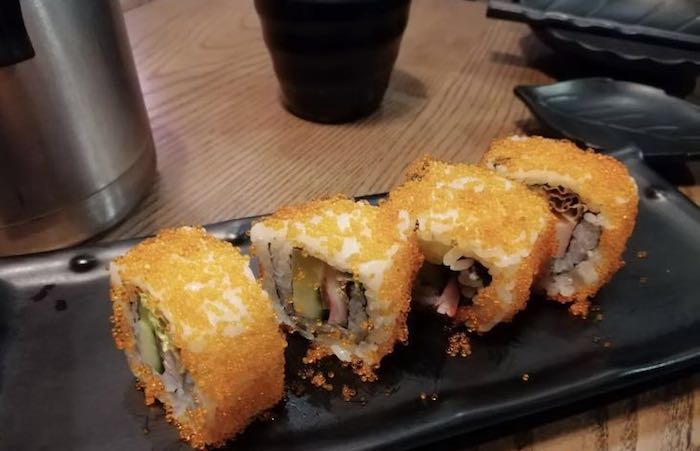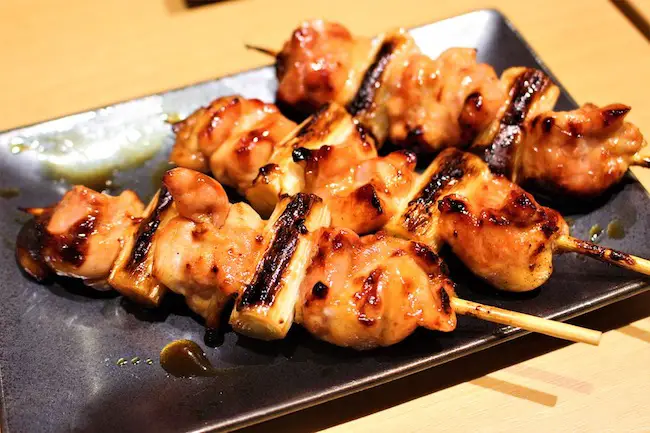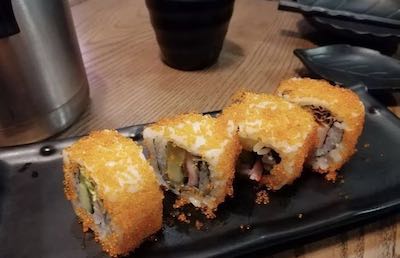We are reader supported. When you purchase through links on our site, we may earn an affiliate commission. Also, as an Amazon affiliate, we earn from qualifying purchases.

Sushi is synonymous with Japanese food. Japan has inspired a variety of Sushi recipes that are now popular across America, and none more-so than the California Roll. However, the very name is suggestive and leads many to wonder whether the California Roll is American or Japanese.
So, is the California Roll American or Japanese? More precisely, will you find the California roll in Japan?
In terms of popularity, California rolls are American. However, they trace their roots to Vancouver, Canada – the name caught on because of the popularity with patrons from Los Angeles. California rolls are also available in Japan, but they are rare and unpopular with the Japanese.
The California Roll is Still New (and Strange) to the Japanese
As the name suggests, the California roll (see recipe) has its roots in California. It looks eerily similar to Japanese sushi, but it is fundamentally different in ingredients, preparation, and taste.
History of the California Roll
The California roll is considered the ideal introduction to (real) sushi. This is because it doesn’t contain raw fish, which is the main ingredient in Japanese sushi.
The name ‘California roll’ is somewhat misleading as the sushi was first created in Vancouver, Canada. Its creator, Hidekazu Tojo, had been raised in Japan where he learnt the art of making sushi. He eventually moved to Canada where he opened his first Japanese restaurant in Vancouver and began selling sushi. However, the Canadians and Americans had their reservations about eating raw fish and seaweed, so Tojo had to come up with a variation to suit their preferences.
To start with, Hidekazu Tojo substituted raw fish with cooked imitation crab meat as most Westerners considered raw fish unhealthy and, well, distasteful. Next, Tojo concealed the raw seaweed by wrapping it inside the curved rice, thus giving birth to the inside-out wrapping which is now popular in a variety of sushi recipes. Finally, Tojo replaced raw tuna meat with a variety of vegetables including avocado and cucumber. And thus the California roll was born. Interestingly, vegans have also come up with their own version of the California roll which replaces imitation crab meat with a variety of vegetables designed to mimic the former’s flavor and texture.
The California roll also differs from classic Japanese sushi when it comes to dining. This is because Americas and Westerners, in general, tend to use too much salt and sauce when eating the California roll. This gets in the way of the seaweed’s flavor, and the flavor of raw fish is virtually non-existent.
Albeit it was invented in Vancouver, Canada, the California roll got its name from its popularity with Americans who toured the city, most of who were from the Golden State of California.
A New Concept in Japan
The California roll is now popular across the Western countries, and of late it has also spread across Asia and even the birthplace of sushi: Japan. However, it is still a new and rare concept as very few restaurants in the country have it on their menus. What’s more, the few restaurants that list the California roll in their menu have an aversion to it – you will likely get a puzzled look from the chef and waiter if you choose to order one as very few people eat it.
Interestingly, most Japanese seem to have an aversion to the California roll just as Westerners had an aversion to eating raw fish in authentic Japanese sushi. The lack of raw fish and presence of cooked imitation crab (imitation crab is hard to find in Japan), as well as the use of too much sauce, is considered off-putting by most Japanese who try the California roll for the first time – You can have a look at this video of random Japanese people trying the California roll for the first time says it all.
Nevertheless, the Japanese government still considers the California roll as Japan’s creation considering that it is inspired by Japanese cuisine – besides, it shares some similarities with classic Japanese sushi. To this end, Japan’s government demonstrated this stand by awarding Hidekazu Tojo with one of the country’s highest honors for creating the California roll: Cultural Ambassador. There are as few as a dozen foreigners who hold this title which Mr. Tojo has now held since 2016.
Other ‘Japanese’ Foods Popular Across America but Rare in Japan
The California roll is not the only un-Japanese dish that is considered Japanese. Japanese restaurants across the west have a variety of other dishes that are considered Japanese but virtually non-existent in the country. They include:
Teriyaki
The word ‘Teriyaki’ is indeed Japanese, but the sauce for which it stands is not. In fact, the word itself is likely used more in the West than it is in Japan.
Teriyaki is made using a variety of ingredients including garlic and pineapple juice. It has a sweet and savory flavor that makes it an ideal dipping sauce or marinade for red meat, but it also goes down well with white meat.

Japanese people tend to use soy sauce (known as shouyu) instead of teriyaki. Unlike teriyaki, soy sauce has a citrusy vinegar base and an acidic flavor that goes down well with the variety of fish and white meats popular across the country. It is also worth mentioning that red meat is rare in Japan – Japanese staple foods mainly consist of fish and vegetables. However, if you find teriyaki sauce in Japan you will notice a notable difference in its taste and flavor – it will be more spicy and acidic than sweet and savory.
Chicken
Chicken is a common and popular dish in Japanese restaurants across the West. Chicken dishes in Japanese restaurants are served as wings with the only difference being that they are flavored using Japanese sauces and spices – a few restaurants also serve chicken in stir-fry and breast recipes. Chicken meat in these restaurants is often served with rice and noodles.
In contrast, chicken is a rare item in menus across restaurants in Japan. This, however, doesn’t mean that chicken is non-existent in Japan – it means that chicken dishes are mostly prepared at home. Chicken in Japan comes in two forms: yakitori and kara-age. Preparation is also considerably different compared to the West: yakitori chicken is simply chopped, skewered, and grilled while coated with a variety of Japanese spices and flavors while Kara-age chicken is marinated in shoyuu, fried in oil, and lightly breaded. Japanese chicken is also very fatty.
Related Questions
Q: Are California rolls Japanese?
A: No, California rolls are not Japanese. They trace their roots to Vancouver, Canada, and are most popular in America and especially in California. They are, however, inspired by Japanese sushi and most people who do not know better consider them to be Japanese.
Q: How are California rolls similar to Japanese sushi?
A: The greatest similarity between California rolls and Japanese sushi is that they both feature nori (seaweed). They also look eerily similar when the nori is wrapped outside the rice, albeit in most cases it is wrapped within. The taste is also somewhat similar depending on the amount of sauce used.
Q: How are California rolls different from Japanese sushi?
A: The main difference between the California roll and Japanese sushi is that the former contains cooked imitation crab while the latter contains raw fish and tuna. The former also features vegetables such as avocado and cucumber while Japanese sushi is mostly stuffed with fish and tuna. Their tastes are also different depending on the former’s preparation. For more information, you can have a look at my previous article – Difference Between Japanese Sushi And American Sushi

